Dichloroaniline
Dichloroanilines are chemical compounds which consist of an aniline ring substituted with two chlorine atoms and have the molecular formula C6H5Cl2N. There are six isomers, varying in the positions of the chlorine atoms around the ring relative to the amino group. As aniline derivatives, they are named with the amino group in position 1. They are all colorless, although commercial samples can appear colored due to the presence of impurities. Several derivatives are used in the production of dyes and herbicides.[1]
| Compound name | CAS# | Chemical structure | Melting point |
|---|---|---|---|
| 2,3-Dichloroaniline | 608-27-5 | 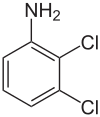 | 20–25 °C (68–77 °F)[2] |
| 2,4-Dichloroaniline | 554-00-7 | 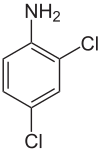 | 59–62 °C (138–144 °F)[3] |
| 2,5-Dichloroaniline | 95-82-9 | 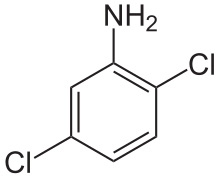 | 47–50 °C (117–122 °F)[4] |
| 2,6-Dichloroaniline | 608-31-1 | 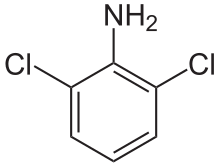 | 36–38 °C (97–100 °F)[5] |
| 3,4-Dichloroaniline | 95-76-1 | 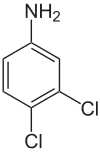 | |
| 3,5-Dichloroaniline | 626-43-7 | 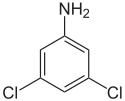 | 46–52 °C (115–126 °F)[7] |
References
- Thomas Kahl, Kai-Wilfrid Schröder, F. R. Lawrence, W. J. Marshall, Hartmut Höke, Rudolf Jäckh "Aniline" in Ullmann's Encyclopedia of Industrial Chemistry, 2007; John Wiley & Sons: New York. doi:10.1002/14356007.a02_303
- "2,3-Dichloroanline". Sigma-Aldrich.
- "2,4-Dichloroanline". Sigma-Aldrich.
- "2,5-Dichloroanline". Sigma-Aldrich.
- "2,6-Dichloroanline". Sigma-Aldrich.
- "3,4-Dichloroanline". Sigma-Aldrich.
- "3,5-Dichloroanline". Sigma-Aldrich.
This article is issued from Wikipedia. The text is licensed under Creative Commons - Attribution - Sharealike. Additional terms may apply for the media files.